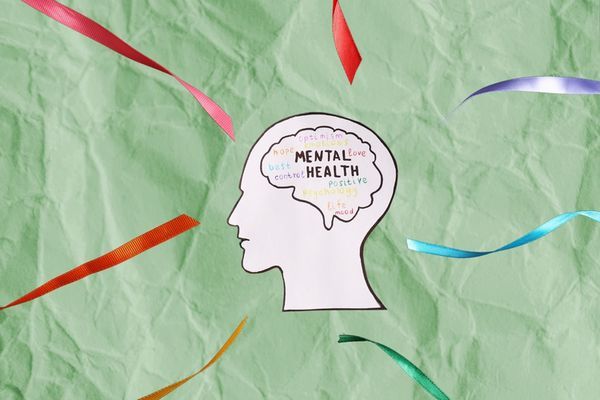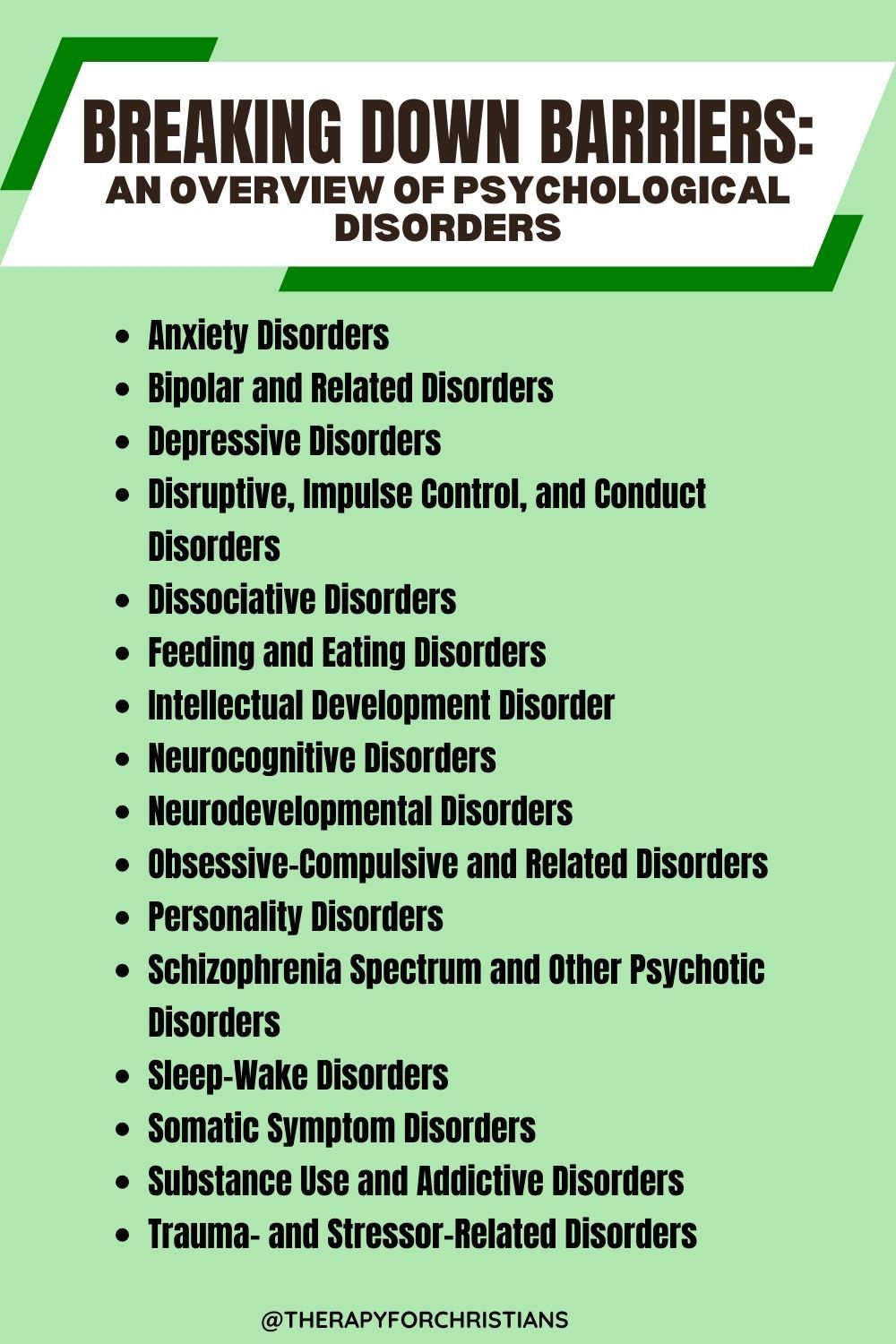

Mental health, often shrouded in misconception and stigma, is an integral part of our overall well-being. Alarmingly, 1 in every 8 people in the world live with a mental disorder, which can manifest as significant disturbances in thinking, emotional regulation, or behavior. These disorders encompass a wide spectrum of conditions, each with unique challenges and impacts on daily life. Despite the existence of effective prevention and treatment options, a majority of affected individuals remain outside the realm of proper care, primarily due to a lack of resources, awareness, and pervasive social stigma. This document aims to shed light on the various types of psychological diseases, with the hope of providing a better understanding and advocating for more inclusive and accessible mental health services for all.

Anxiety Disorders
Anxiety disorders represent a group of mental conditions that are characterized by significant feelings of anxiety and fear. Such disorders are among the most common mental health issues and markedly affect a person's ability to function in daily life. Symptoms can range from general nervousness to debilitating panic attacks. Despite their prevalence, anxiety disorders are often misunderstood and can be improperly labeled as mere stress or nervousness. However, with appropriate treatment, individuals can manage symptoms effectively and lead fulfilling lives.
Generalized Anxiety Disorder (GAD)
Generalized Anxiety Disorder (GAD) is a chronic condition hallmarked by persistent, excessive worry about various aspects of daily life. Individuals with GAD may feel anxious about work responsibilities, personal health, or the safety of loved ones, even when there is no evident reason for concern. Physical manifestations might include restlessness, fatigue, muscle tension, and sleep disturbances. Often, the worry and the associated symptoms are difficult to control and can significantly impair social, occupational, and personal function.
Social Anxiety Disorder
Social Anxiety Disorder is characterized by an intense fear of social situations in which the individual anticipates being scrutinized or judged by others. This overwhelming worry about social interactions can disrupt everyday activities and severely hamper one's ability to form relationships. People with Social Anxiety Disorder often feel powerless in the face of their anxiety, which can lead to avoidance of social events and isolation, further exacerbating their symptoms.
Specific Phobias
Specific Phobias involve an irrational and excessive fear of a particular object or situation. Common phobias include fears of heights (acrophobia), spiders (arachnophobia), and flying (aviophobia). The mere thought or presence of the phobic stimulus can trigger an immediate anxiety response, possibly leading to a full-blown panic attack. Although individuals with specific phobias realize that their fear is disproportionate to the actual threat, this understanding does little to ease their anxiety.
Panic Disorder
Panic Disorder is distinguished by recurrent, unexpected panic attacks—sudden onslaughts of intense fear or discomfort peaking within minutes. During a panic attack, individuals might experience palpitations, pounding heart, trembling, shortness of breath, and a fear of losing control or impending doom. Panic Disorder can cause substantial emotional distress and can sometimes lead to the development of agoraphobia, where individuals avoid places or situations for fear of triggering a panic attack.

Separation Anxiety Disorder
Separation Anxiety Disorder is typically associated with children, but it can also afflict adults. It is marked by excessive fear or anxiety concerning separation from home or attachment figures. In children, this may manifest as distress when apart from parents or caregivers, and in adults, it may involve worry about the well-being of close family members or partners when separated. The disorder can lead to significant problems in social, academic, or occupational functioning, and it often requires therapeutic intervention for improvement.
Trauma- and Stressor-Related Disorders
Trauma- and Stressor-Related Disorders are a category of mental disorders that are distinctly characterized by the onset or exacerbation of symptoms following exposure to a traumatic or stressful event. Unlike anxiety disorders, which can develop without an identifiable trigger, these disorders are directly linked to external life incidents. This group was previously lumped together with anxiety disorders, but due to their unique traits and treatment approaches, they have been reclassified into their own category.
Acute Stress Disorder
Acute Stress Disorder (ASD) manifests shortly after exposure to a traumatic event and is marked by symptoms similar to those of Post-Traumatic Stress Disorder (PTSD), including intrusive memories, negative mood, dissociative symptoms like feeling detached from oneself, avoidance behaviors, and heightened arousal and reactivity. The key difference is that ASD symptoms occur within one month after the trauma and are typically resolvable with time. If symptoms persist beyond a month, this may evolve into PTSD, necessitating more intensive intervention.
Adjustment Disorders
Adjustment Disorders are stress-related mental health conditions that arise in response to a significant life change or stressful event that causes emotional or behavioral symptoms exceeding what would normally be expected from that event. Symptoms may include feelings of hopelessness, frequent crying, anxiety, and disturbances to normal sleeping or eating patterns, which can impede personal and social functioning. Crucially, with proper support, affected individuals can recover from an Adjustment Disorder, often within a few months.
Post-Traumatic Stress Disorder (PTSD)
Post-Traumatic Stress Disorder (PTSD) develops after an individual has experienced or witnessed a life-threatening event or trauma. Characterized by persistent re-experiencing of the trauma through flashbacks or nightmares, avoidance of reminders of the event, negative changes in thoughts and mood, and a heightened state of arousal, PTSD can lead to significant impairment over months or years. Effective treatments include psychotherapy, such as Cognitive Behavioral Therapy and Eye Movement Desensitization and Reprocessing, as well as certain medications.

Reactive Attachment Disorder
Reactive Attachment Disorder (RAD) is a rare but serious condition found in children who have experienced grossly inadequate care, such as severe neglect or absence of comforting and affectionate caregivers. These children struggle to form any meaningful attachments to others, displaying a persistent emotional detachment, resistance to comforting, and social and emotional withdrawal. Treatment for RAD focuses on creating a stable and nurturing environment for the child, with consistent caregivers to encourage positive attachments.
Depressive Disorders
Depressive disorders encompass a range of conditions characterized by persistent feelings of sadness and a lack of interest or pleasure in daily activities. These disorders can lead to a variety of emotional and physical problems and can decrease a person's ability to function at work and at home. The intensity, duration, and frequency of symptoms vary depending on the type and severity of the disorder.
Disruptive Mood Dysregulation Disorder
Disruptive Mood Dysregulation Disorder (DMDD) is a condition seen in children and adolescents, characterized by severe and recurrent temper outbursts that are disproportionate to the situation or provocation. These outbursts, which can be verbal or behavioral, are inconsistent with the child's developmental level. Between these outbursts, the child experiences persistent irritability or anger nearly every day. The diagnosis of DMDD was created to address the need for better classification of children with these symptoms, who had previously been diagnosed with pediatric bipolar disorder.
Major Depressive Disorder
Major Depressive Disorder (MDD), also known as clinical depression, involves a pervasive and persistent low mood accompanied by low self-esteem and a loss of interest or pleasure in normally enjoyable activities. MDD can significantly interfere with daily activities, such as sleeping, eating, working, and maintaining relationships. It is typically treated with psychotherapy and/or antidepressant medications, and in some severe cases, other interventions like electroconvulsive therapy may be utilized.
Persistent Depressive Disorder
Persistent Depressive Disorder (PDD), also known as dysthymia, is a form of depression that lasts for at least two years (one year for children and adolescents). It involves a chronic state of depression; individuals may experience less severe symptoms than those with major depression but they are more enduring. Symptoms include a deep sadness, hopelessness, low self-esteem, lack of productivity, and overall feelings of inadequacy. Treatment is similar to that of major depressive disorder, combining therapy with medication.
Other Specified Depressive Disorder
Other Specified Depressive Disorder is a category used for individuals experiencing significant depression symptoms that do not align with the criteria for other depressive disorders. This category allows for flexibility and specificity when diagnosing and treating depression that is present but does not fit neatly into the conventional diagnostic criteria, enabling mental health professionals to offer targeted treatment nevertheless.
Premenstrual Dysphoric Disorder
Premenstrual Dysphoric Disorder (PMDD) is a severe form of premenstrual syndrome (PMS). It is characterized by emotional and physical symptoms that seriously disrupt a woman's life, often interfering with work, school, social activities, and relationships. Symptoms typically occur during the luteal phase of the menstrual cycle and can include mood swings, irritability or anger, depression, anxiety, feelings of overwhelm, and a range of physical symptoms. Treatment options may include lifestyle changes, counseling, and medication.
Substance/Medication-Induced Depressive Disorder
Substance/Medication-Induced Depressive Disorder is a form of depression that is directly caused by the use or abuse of substances like alcohol, drugs, medications, or exposure to a toxin. Symptoms can be similar to those of major depressive disorder but are specifically attributed to the effects of the implicated substance. Stopping the use of the substance usually improves symptoms, though additional treatment strategies may be necessary.
Depressive Disorder Due to Another Medical Condition
Depressive Disorder Due to Another Medical Condition is depression that is believed to be directly caused by another physical health problem. This diagnosis is given when the depression is a direct physiological consequence of a separate medical condition, such as a thyroid disorder, Parkinson's disease, or cancer. The treatment approach includes managing the underlying medical condition as well as the depressive symptoms, often with a combination of medications and psychotherapy.
Bipolar and Related Disorders
Bipolar and related disorders are characterized by shifts in mood, energy, and activity levels that can affect a person's ability to carry out day-to-day tasks. These disorders include both high (manic or hypomanic) and low (depressive) mood episodes. The course of bipolar disorders can vary, and the specific diagnosis is made based on the pattern, severity, and frequency of mood episodes.
Mania
Mania is a distinct period of abnormally and persistently elevated, expansive, or irritable mood and increased goal-directed activity or energy. Symptoms may include inflated self-esteem or grandiosity, decreased need for sleep, being more talkative than usual, racing thoughts, distractibility, an increase in goal-directed activity, or excessive involvement in activities with a high potential for painful consequences. Manic episodes are often severe enough to cause marked impairment in social or occupational functioning.
Depressive Episodes
Depressive episodes, in the context of bipolar disorder, involve periods where the affected person experiences a depressed mood or a noticeable loss of interest or pleasure in nearly all activities. These episodes include additional symptoms such as significant weight loss or gain, insomnia or hypersomnia, psychomotor agitation or retardation, fatigue or loss of energy, feelings of worthlessness, diminished ability to think or concentrate, and recurrent thoughts of death.
Neurodevelopmental Disorders
Neurodevelopmental disorders are a group of conditions that typically manifest early in a child's development, often before the child enters grade school, and are characterized by developmental deficits that can affect personal, social, academic, or occupational functioning.
Intellectual Development Disorder
Intellectual Development Disorder (IDD), formerly known as intellectual disability, is characterized by limitations in intellectual functioning and adaptive behavior, covering many everyday social and practical skills. This disorder originates before the age of 18 and is measured through IQ testing and an assessment of adaptive behaviors.
Global Developmental Delay
Global Developmental Delay is used to describe young children under the age of five who show significant delay in two or more developmental domains such as motor, speech, social, or daily living skills. Long-term outcomes may include the development of a specific learning disorder or intellectual development disorder.
Communication Disorders
Communication disorders encompass a wide range of problems in language, speech, and communication, which can manifest as an inability to understand or produce language, or difficulty with the mechanics and social use of speech and language. These disorders can significantly impede academic achievement and day-to-day living.
Autism Spectrum Disorder
Autism Spectrum Disorder (ASD) is a complex neurobehavioral condition that includes impairments in social interaction and developmental language and communication skills combined with rigid, repetitive behaviors. The spectrum covers a range of challenges and skills, where individuals with ASD may require substantial support for daily living while others may be highly skilled and semi-independent.
Attention-Deficit Hyperactivity Disorder (ADHD)
Attention-Deficit Hyperactivity Disorder (ADHD) is a neurological disorder characterized by a pattern of inattention and/or hyperactivity-impulsivity that interferes with functioning or development. Presenting in two types—primarily inattentive or primarily hyperactive/impulsive—ADHD can affect children's performance at school, their relationships, and potentially continue into adulthood.
Dissociative Disorders
Dissociative Disorders are a group of psychiatric conditions distinguished by disruptions in the usually integrated functions of consciousness, memory, identity, emotion, perception, body representation, motor control, and behavior. These disturbances may result in a fragmentation of the individual's sense of self and can cause significant impairment in social and occupational functioning. The exact mechanisms leading to dissociative disorders are still being studied, but they are often linked to traumatic experiences, stress, or developmental disruptions during key periods of cognitive development.
Dissociative Amnesia
Dissociative Amnesia is characterized by an inability to recall important personal information, usually of a traumatic or stressful nature, which cannot be explained by ordinary forgetfulness. The scope of memory loss varies significantly, from forgetting specific events to complete loss of identity and life history. The amnesia may be localized to a specific event, selective, or generalized. Individuals with this disorder may experience significant anxiety and perplexity due to the gaps in their memories and often benefit from therapeutic interventions aimed at coping with stress and trauma.
Dissociative Identity Disorder
Dissociative Identity Disorder (DID), formerly known as multiple personality disorder, involves the presence of two or more distinct identity states or personality states that recurrently take control of the individual's behavior, accompanied by an inability to recall personal information beyond what is expected through normal forgetfulness. Each identity may have its own name, age, history, and characteristics, including distinct postures, gestures, and mannerisms. DID is associated with overwhelming experiences, traumatic events, and abuse occurring in childhood, as well as cultural and sociological influences.
Depersonalization/Derealization Disorder
Depersonalization/Derealization Disorder is characterized by persistent or repeated episodes of depersonalization, feelings of detachment or estrangement from one's self, or derealization, a sense of unreality or detachment from the environment. Individuals may feel as though they are outside observers of their own lives or that their surroundings are unreal or distorted. These experiences can be very disturbing and may interfere significantly with life functioning, though individuals with this disorder do not lose contact with reality. Treatment often involves psychotherapy to address underlying stressors and trauma and to develop coping strategies.
Somatic Symptom Disorders
Somatic Symptom Disorders are a group of disorders characterized by an intense focus on physical symptoms — such as pain or fatigue — that causes major emotional distress and problems functioning. Individuals may or may not have an associated medical condition, but they experience excessive thoughts, feelings, or behaviors related to the symptoms, which impact their daily lives. These concerns might result in frequent doctor visits or tests, reluctance to engage in routine activities, or the development of depression or anxiety.
Somatic Symptom Disorder
Somatic Symptom Disorder involves one or more chronic physical complaints that are not fully explained by any known medical conditions. Patients usually have excessive and disproportionate thoughts, feelings, and behaviors related to these symptoms, causing significant distress and impairment. The continual search for explanations and relief can lead to unnecessary medical assessments, a strain on healthcare resources, and a reduced quality of life for the sufferer.
Illness Anxiety Disorder
Previously known as hypochondriasis, Illness Anxiety Disorder involves excessive worry about having or developing a serious mental illnesses despite having no or only minor symptoms. This disorder can consume one's thoughts and daily activities. Sufferers often misinterpret normal bodily functions as signs of serious illness, leading to frequent medical appointments, numerous tests, and sometimes-caustic interactions with health professionals when no medical explanation is found.
Conversion Disorder
Conversion Disorder, also known as Functional Neurological Symptom Disorder, is characterized by neurological symptoms that are inconsistent with, or cannot be fully explained by, medical or neurological conditions. Symptoms may include sudden loss of vision, paralysis, or seizures without a neurological basis. These outcomes are thought to be an unconscious response to psychological conflict or stress.
Factitious Disorder
Factitious Disorder, also known as Munchausen syndrome, is a severe mental disorder in which someone deceives others by appearing sick, purposefully getting sick, or by self-injury. Unlike other somatic symptom disorders, people with Factitious Disorder are willing to undergo painful or risky tests and operations in order to get the sympathy and special attention given to people who are truly ill. This disorder is associated with severe emotional difficulties and problems in interpersonal relationships.
Feeding and Eating Disorders
Feeding and Eating Disorders are characterized by a persistent disturbance of eating or eating-related behavior that results in the altered consumption or absorption of food and significantly impairs physical health or psychosocial functioning. The disorders often involve a preoccupation with food, body weight, and shape, potentially leading to dangerous health consequences. These disorders are multifaceted and may involve a combination of genetic, biological, behavioral, psychological, and social factors.
Anorexia Nervosa
Anorexia Nervosa is an eating disorder marked by an intense fear of gaining weight and a distorted body image which leads to restricted food intake and excessive weight loss. Individuals suffering from this condition often have an extremely low body weight and a relentless pursuit of thinness, often accompanied by an inability to accurately perceive the severity of their underweight condition. Anorexia Nervosa can have serious health repercussions, including heart and kidney problems, and can be fatal if not treated.
Bulimia Nervosa
Bulimia Nervosa is characterized by recurrent and frequent episodes of eating unusually large amounts of food (binge eating), followed by behavior that compensates for the overeating, such as forced vomiting, excessive use of laxatives, fasting, or excessive exercise. Unlike Anorexia Nervosa, weight is typically within the normal range or slightly above, making it less noticeable and therefore often more difficult to diagnose and treat. Individuals with bulimia may feel a lack of control during the binge-eating episodes and experience intense shame or guilt.
Rumination Disorder
Rumination Disorder is a condition in which a person repeatedly regurgitates their food, which may then be re-chewed, re-swallowed, or spit out. This disorder can develop in infancy, childhood, or adulthood, and if persistent, may lead to weight loss and malnutrition. It is distinct from other eating disorders as it is a reflexive action, not driven by concerns about body image or a desire to lose weight.
Pica
Pica is an eating disorder involving the persistent ingestion of non-nutritive, non-food substances over a period of at least one month. The consumed items can include items such as soil, chalk, laundry detergent, or paint chips. The condition can affect children, adolescents, and adults and is particularly concerning due to the potential for ingestion of harmful substances, which can lead to serious medical complications such as lead poisoning or intestinal blockages.
Binge Eating Disorder
Binge Eating Disorder (BED) is defined by recurrent episodes of eating large quantities of food in a short time period, often to the point of discomfort, and a feeling of loss of control during the episodes. Unlike bulimia nervosa, there are no regular attempts to 'make up' for the binges through vomiting, fasting, or excessive exercise. BED is frequently associated with significant psychological and emotional distress and can increase the risk of developing other health problems, such as cardiovascular disease and type 2 diabetes.
Sleep-Wake Disorders
Sleep-Wake Disorders encompass a variety of conditions that affect the quality, timing, and amount of sleep, which can lead to distress and impairment in daytime functioning. These disorders may also be interconnected with other medical or psychiatric issues, though they are considered distinct entities within the realm of sleep-related problems. Proper diagnosis and management of these disorders are crucial as chronic sleep disturbances can contribute to health issues such as obesity, heart disease, diabetes, and depression.
Narcolepsy
Narcolepsy is a chronic sleep disorder characterized by overwhelming daytime drowsiness and sudden attacks of sleep, which can severely disrupt a person's daily life. It occurs due to the brain's inability to regulate sleep-wake cycles normally. People with narcolepsy may experience cataplexy—a sudden, brief loss of voluntary muscle tone triggered by strong emotions—which can further complicate the condition. While there is no cure, symptoms can be managed with lifestyle changes and medication.
Insomnia Disorder
Insomnia Disorder is one of the most common sleep disorders and involves persistent difficulty falling asleep, staying asleep, or waking too early without being able to return to sleep. It often accompanies stress, lifestyle habits, or other underlying conditions. The consequences of insomnia include daytime fatigue, mood disturbances, and reduced performance at work or school. Treatment typically involves cognitive behavioral therapy for insomnia (CBT-I) and, in some cases, medication.
Hypersomnolence Disorder
Hypersomnolence Disorder, also known as hypersomnia, is characterized by excessive daytime sleepiness despite adequate nighttime sleep, or prolonged, non-restorative sleep episodes. Sufferers often have difficulty waking from a long sleep period and may feel compelled to nap repeatedly during the day, often at inappropriate times. It can be a primary condition or associated with other medical issues, but in either case, it can severely impact an individual’s daily activities.
Breathing-Related Sleep Disorders
Breathing-Related Sleep Disorders refer to sleep disturbances that are primarily attributed to breathing issues, such as Obstructive Sleep Apnea (OSA), where the throat muscles intermittently relax and obstruct the airway during sleep. Symptoms include heavy snoring and feeling tired even after a full night's sleep. These disorders can lead to serious health complications like hypertension and heart disease, making recognition and treatment paramount.
Parasomnias
Parasomnias are a category of sleep disorders involving abnormal movements, behaviors, emotions, perceptions, and dreams that occur while falling asleep, sleeping, between sleep stages, or upon waking. Nightmares, night terrors, sleepwalking, and sleep talking are all examples of parasomnias. While often less serious, they can be distressing and may require intervention if they pose a risk of injury or significant sleep disruption.
Restless Legs Syndrome
Restless Legs Syndrome (RLS) is a neurological disorder manifesting as an uncontrollable urge to move the legs, typically in the evenings. Symptoms are often described as aching, throbbing, or crawling sensations, and movement provides temporary relief. RLS is not only a source of discomfort but also a contributing factor to insomnia and subsequent daytime impairment. Treatment may include lifestyle modification and medication to manage symptoms.
Disruptive, Impulse Control, and Conduct Disorders
Disruptive, Impulse Control, and Conduct Disorders embody a spectrum of conditions characterized by an individual's inability to resist impulses or engage in behaviors that are harmful to themselves or others. These disorders often manifest during childhood or adolescence and can have profound implications for an individual's social interactions, education, and work opportunities. People with these conditions may exhibit aggression, deceitfulness, rule violation, and a lack of empathy or remorse.
Kleptomania
Kleptomania is an impulse control disorder that is marked by an uncontrollable urge to steal items that are not needed for personal use or monetary value. The act of stealing may provide a release of tension for the affected individual, followed by gratification or relief. However, this is often accompanied by significant shame or guilt post-theft. Kleptomania is a perplexing condition that can lead to legal consequences and can co-occur with other mood and anxiety disorders.
Pyromania
Pyromania is characterized by an impulse to deliberately start fires to relieve tension or for instant gratification, followed by feelings of pleasure or relief when setting or witnessing fires. Unlike arson, which is fire-setting for personal, monetary or political gain, pyromania is driven by pure fascination, and the behavior is not better explained by conduct disorder, a manic episode, or anti-social personality disorder. Treatment often involves psychotherapy and sometimes medication.
Intermittent Explosive Disorder
Intermittent Explosive Disorder is a condition characterized by sudden episodes of unwarranted anger and aggression that are out of proportion to the situation at hand. These explosive outbursts can include verbal tirades, physical violence, or property destruction, and they often result in significant relationship, occupational, and legal difficulties. The disorder calls for careful assessment and management, which may include cognitive behavioral therapy and medication.
Conduct Disorder
Conduct Disorder presents as a repetitive and persistent pattern of behavior that violates the basic rights of others and societal norms or rules. Behaviors typical in conduct disorder include aggression towards people or animals, destruction of property, deceitfulness, theft, and serious rule violations. These behaviors can lead to significant functional impairment in a person’s life. Early intervention and treatment are vital and may include psychotherapy and parent training programs.
Oppositional Defiant Disorder
Oppositional Defiant Disorder is characterized by a recurrent pattern of argumentative and defiant behavior towards authority figures, which goes beyond the bounds of typical childhood behavior. Symptoms include frequent temper tantrums, refusal to comply with rules, deliberate attempts to annoy others, and a tendency to blame others for one's own mistakes. Family therapy and behavior modification strategies are common approaches to treatment for this disorder.
Substance Use and Addictive Disorders
Substance Use and Addictive Disorders encompass a complex array of conditions characterized by the excessive and harmful use of substances like alcohol, cannabis, inhalants, and stimulants, as well as engagement in behaviors such as gambling. These disorders can significantly impair one's ability to function in daily life and may lead to severe health, social, and legal consequences.
Alcohol-related Disorders
Alcohol-related disorders involve the misuse and dependency on alcohol, where the consumption patterns lead to significant distress or impairment. The spectrum ranges from Alcohol Use Disorder (AUD) to alcohol intoxication and withdrawal. Symptoms of AUD include a strong craving for alcohol, inability to limit drinking, continued use despite negative personal or social consequences, and physical symptoms like tolerance and withdrawal.
Cannabis-related Disorders
Cannabis-related disorders encompass conditions associated with the use of marijuana or its derivatives. Despite varying legal statuses across jurisdictions, problems arise when use becomes excessive or compulsive, rising to the level of a use disorder. Symptoms can include craving, loss of control over the amount or frequency of use, and continued use despite social or interpersonal problems.
Inhalant-use Disorders
Inhalant-use disorders are the result of repeated abuse of inhalant substances—volatile hydrocarbons found in products like glue, paint thinners, or nitrous oxide—that lead to psychological and physical dependence. Users experience short-term euphoria, but with repeated use, may suffer from long-term neurocognitive damage, organ system damage, or sudden death from 'sniffing' or 'huffing.'
Stimulant Use Disorder
Stimulant use disorder refers to the dependence on stimulants, such as cocaine, methamphetamine, and prescription medications like ADHD drugs. Symptoms include tolerance, craving, withdrawal symptoms, and continued use despite knowledge of the harm it is causing. This disorder not only has a high potential for addiction but also poses significant health risks, including cardiovascular damage and increased likelihood of infectious diseases.
Tobacco Use Disorder
Tobacco use disorder is characterized by dependence on nicotine products, such as cigarettes, chewing tobacco, or vaping. Individuals experience cravings, withdrawal symptoms upon cessation, and persistent use despite awareness of the health risks, including cancer, heart disease, and respiratory illness. This dependence is one of the most challenging to overcome due to the widespread availability and social acceptance of tobacco use.
Gambling Disorder
Gambling Disorder is a behavioral addiction recognized by an inability to resist the urge to gamble, leading to detrimental personal, financial, and social outcomes. Those affected are preoccupied with gambling, often using it as a means to escape problems or feelings of helplessness, guilt, anxiety, or depression. The behavior persists despite efforts to stop and the strain it causes on their personal and professional lives.
Neurocognitive Disorders
Neurocognitive disorders are a group of conditions that frequently involve impairments in learning, memory, perception, and problem-solving. These disorders have various etiologies, such as brain injury, neurodegenerative diseases, or vascular disorders. The cognitive decline associated with these disorders significantly interferes with independence and daily functioning, prompting a need for a comprehensive approach to diagnosis, treatment, and management.
Delirium
Delirium is an acute, typically reversible, condition characterized by a sudden change in cognition and attention. This state of confusion often arises quickly over hours or days and may fluctuate during the course of a day. Potential triggers include medical conditions, medication, surgery, or substance withdrawal. Symptoms involve disorientation, difficulty with memory, language, and visuospatial ability, as well as emotional disturbances. Effective management of delirium involves identifying and treating the underlying cause, ensuring patient safety, and providing supportive care.
Other Neurocognitive Disorders
Other Neurocognitive Disorders include a broad spectrum of diseases such as Major Neurocognitive Disorder, commonly known as dementia, and its numerous types like Alzheimer's disease, Frontotemporal dementia, and Lewy Body dementia, as well as Mild Neurocognitive Disorder. These disorders are often chronic and progressive, leading to a deterioration in cognitive functions. Assessment and management may involve pharmacological treatments, cognitive therapies, and support for caregivers. Early diagnosis and intervention are critical for improving quality of life and slowing the progression of symptoms.
Schizophrenia Spectrum and Other Psychotic Disorders
Schizophrenia Spectrum and Other Psychotic Disorders are characterized by alterations in perception, beliefs, and thought processes. The core symptoms are often categorized into positive symptoms, which include hallucinations and delusions, and negative symptoms, such as diminished emotional expression or avolition. Schizophrenia is the most well-known of these disorders, where individuals may experience a profound disconnect from reality. Other psychotic disorders include schizotypal personality disorder, delusional disorder, and schizoaffective disorder, each with its unique set of symptoms and challenges. Diagnosis is typically made through a comprehensive psychiatric evaluation, and treatment often involves a combination of antipsychotic medications and psychotherapy, aimed at reducing symptom severity and improving quality of life.
Obsessive-Compulsive and Related Disorders
Obsessive-Compulsive and Related Disorders are a cluster of mental health conditions marked by recurrent and persistent thoughts (obsessions) and repetitive behaviors (compulsions). These behaviors are experienced as distressing and often interere with daily functioning and social interactions. Beyond classic OCD, this category includes a spectrum of disorders with similar features but distinct manifestations.
Body Dysmorphic Disorder
Body Dysmorphic Disorder (BDD) is characterized by an excessive preoccupation with one or more perceived flaws in physical appearance, which are not observable or appear slight to others. This concern often leads to repetitive behaviors, such as mirror checking or excessive grooming, and mental acts, including constant comparison to others. BDD can significantly impair an individual's social and occupational functioning and is often associated with a high risk of psychiatric comorbidity.
Hoarding Disorder
Hoarding Disorder involves a persistent difficulty parting with possessions, regardless of their actual value. This difficulty is due to a perceived need to save the items and the distress associated with discarding them. Hoarding often results in an accumulation that congests living areas and dramatically affects the usability of the home. Hoarding Disorder can lead to significant distress, functional impairment, and health hazards, such as fire risk or unhygienic conditions.
Trichotillomania (Hair-Pulling Disorder)
Trichotillomania, commonly known as Hair-Pulling Disorder, involves a recurrent, irresistible urge to pull out hair from the scalp, eyebrows, or other areas of the body, in response to stress or tension. This condition results in noticeable hair loss and can cause significant distress or impairment in social, occupational, or other important areas of functioning. It is frequently accompanied by a sense of relief or pleasure after hair pulling.
Excoriation (Skin-Picking) Disorder
Excoriation Disorder, or Skin-Picking Disorder, is characterized by repetitive and compulsive picking of the skin, leading to tissue damage. Individuals with this disorder pick at healthy skin, minor skin irregularities, lesions, or scabs, often in attempts to remove perceived imperfections. This behavior may result in significant skin damage, distress, and impairment in daily functioning.
Substance/Medication-Induced Obsessive-Compulsive and Related Disorder
Substance/Medication-Induced Obsessive-Compulsive and Related Disorder is the presence of obsessions and compulsions exclusively during or soon after substance intoxication or withdrawal or after exposure to a medication. The disorder causes clinically significant distress or impairment in social, occupational, or other important areas of functioning and is distinguishable from the primary obsessive-compulsive and related disorders due to the direct physiological effects of a substance.
Obsessive-Compulsive and Related Disorder Due to Another Medical Condition
Obsessive-Compulsive and Related Disorder due to Another Medical Condition is characterized by obsessive-compulsive-like symptoms that are the direct physiological result of another medical condition. Diagnosis of this disorder requires evidence from the medical history, physical examination, or laboratory findings that the symptoms are a manifestation of the medical condition. Treatment focuses on managing the underlying medical condition and may involve behavioral or pharmacological interventions to address the obsessions and compulsions.
Personality Disorders
Personality Disorders consist of enduring patterns of inner experience and behavior that deviate markedly from cultural expectations, are pervasive and inflexible, onset in adolescence or early adulthood, are stable over time, and lead to distress or impairment. This category includes various disorders, each with distinct sets of behaviors, experiences, and challenges, impacting an individual's ability to relate to others and to function effectively in life.
Antisocial Personality Disorder
Antisocial Personality Disorder is characterized by a pervasive pattern of disregard for, and violation of, the rights of others that begins in childhood or early adolescence and continues into adulthood. Symptoms may include failure to conform to social norms, deceitfulness, impulsivity, aggressiveness, disregard for the safety of oneself or others, consistent irresponsibility, and lack of remorse after hurting others. Diagnosis requires a history of conduct disorder before the age of 15 and the presence of behaviors that are not exclusively during episodes of schizophrenia or bipolar disorder.
Avoidant Personality Disorder
Avoidant Personality Disorder is marked by social inhibition, feelings of inadequacy, and hypersensitivity to negative evaluation. Individuals with this disorder often display an intense fear of rejection or criticism, leading to avoidance of social interactions and reluctance to take personal risks. Despite a strong desire for companionship, their anxiety and fear of disappointment often inhibit meaningful social or occupational relationships.
Borderline Personality Disorder
Borderline Personality Disorder is identified by a pervasive pattern of instability in interpersonal relationships, self-image, and affects, along with marked impulsivity. People with BPD may experience intense episodes of anger, depression, and anxiety that may last from a few hours to days. They also may struggle with uncertainty about their identity, exhibit self-destructive behaviors, and have a pattern of intense and unstable relationships.
Dependent Personality Disorder
Dependent Personality Disorder features a continuous need for reassurance and care, leading to submissive and clinging behavior and fears of separation. This disorder is characterized by a lack of self-confidence, an inability to make decisions without the input or reassurance of others, difficulty initiating projects, and a willingness to tolerate mistreatment and abuse from others to obtain support.
Histrionic Personality Disorder
Histrionic Personality Disorder involves a pattern of excessive emotion and attention-seeking, including an excessive need for approval and inappropriate seductiveness. It is characterized by rapidly shifting and shallow expression of emotions, a style of speech that is excessively impressionistic and lacking in detail, and a suggestibility that is easily influenced by others or circumstances.
Narcissistic Personality Disorder
Narcissistic Personality Disorder is marked by a grandiose sense of self-importance, a preoccupation with fantasies of unlimited success, and a strong need for excessive admiration, coupled with a lack of empathy for others. Individuals with this disorder often believe they are unique and can only be understood by other special or high-status people, and may regularly display arrogant behaviors and attitudes.
Obsessive-Compulsive Personality Disorder
Obsessive compulsive disorder is characterized by a preoccupation with orderliness, perfectionism, and control at the expense of flexibility, openness, and efficiency. People with this disorder are often overly devoted to work and productivity, exhibit rigidity and stubbornness, and may insist that others submit to their way of doing things.
Paranoid Personality Disorder
Paranoid Personality Disorder involves a pattern of pervasive distrust and suspiciousness of others such that their motives are interpreted as malevolent. Individuals with this disorder may be preoccupied with unjustified doubts about the loyalty or trustworthiness of friends or associates, and may read hidden demeaning or threatening meanings into benign remarks or events.
Schizoid Personality Disorder
Schizoid Personality Disorder is characterized by a pattern of detachment from social relationships and a limited range of emotional expression in interpersonal settings. Individuals with this condition often display a preference for solitary activities, deficient emotional responses, and an indifference to praise or criticism.
Schizotypal Personality Disorder
Schizotypal Personality Disorder is typified by acute discomfort in close relationships, cognitive or perceptual distortions, and eccentricities of behavior. Afflicted individuals may show odd beliefs or magical thinking, unusual perceptual experiences, and peculiar patterns in speech and behavior that hinder their ability to form relationships. This disorder is often seen as part of the schizophrenia spectrum due to its symptomatic overlap with schizophrenia.
Intellectual Development Disorder
Intellectual Development Disorder, previously known as Mental Retardation, involves significant limitations in intellectual functioning and adaptive behavior. Symptoms may include impaired communication and social skills, difficulty with problem-solving and abstract thinking, and challenges with activities of daily living. Diagnosis requires an assessment of both cognitive ability and adaptive behavior.

Final Thoughts on Psychological Disorders
While these are some of the most commonly diagnosed psychological disorders, it is important to note that there are many other conditions recognized by mental health professionals. Additionally, each disorder may present differently for each individual, and a proper diagnosis should always be made by a trained professional through thorough evaluation and assessment.
It is also important to remember that mental illness is not a personal choice or character flaw, but rather a complex interaction of genetic, biological, environmental, and societal factors. With proper treatment and support, individuals with psychological disorders can lead fulfilling lives and manage their symptoms effectively. It is crucial to reduce the stigma surrounding mental illness and promote understanding and compassion for those who may be struggling.
Seeking help for mental health concerns is a sign of strength, not weakness, and everyone deserves access to quality mental health care. If you or someone you know is struggling with a psychological disorder, please reach out for help from a trusted professional.
Remember, recovery is possible. So let's continue the conversation about mental health and work towards creating a more inclusive and supportive society for those living with psychological disorders.
Before you leave, we would appreciate it if you helped us spread the word by sharing, tweeting, pinning, etc. this post.
About the Author:
Corine Williams, Ph.D. is Clinical Psychologist that is currently seeing clients in the States of Maryland, New Jersey, and New York. You can find out more about her practice by visiting www.therapyforchristians.com/corinewilliams. In addition to providing individual therapy, Dr. Williams is also passionate about writing books and designing merchandise that educate, uplift, and normalize mental health subject in the Christian community. You can find out more about her at www.booksbycorine.com or by visiting her amazon profile here: https://www.amazon.com/Corine-Hyman/e/B00AWZ5FL2
Help us increase mental health awareness in the Christian community by donating through our paypal link here: www.paypal.com/therapyforchristians, joining our mailing list by clicking below, or join our provider list here: Provider listing
Disclaimer: the information, including but not limited to, text, graphics, images and other material contained on this article are for informational purposes only. No material on this site is intended to be a substitute for professional medical advice, diagnosis or treatment. If you are looking for a Christian counselor near you, please check out our directory located here: Christians Therapist Near Me
.png)


















